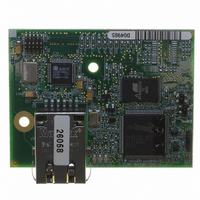20-101-1132 Rabbit Semiconductor, 20-101-1132 Datasheet - Page 28

20-101-1132
Manufacturer Part Number
20-101-1132
Description
MODULE RCM4210 RABBITCORE
Manufacturer
Rabbit Semiconductor
Datasheet
1.20-101-1132.pdf
(134 pages)
Specifications of 20-101-1132
Module/board Type
MPU Core Module
Product
Microcontroller Modules
Core Processor
Rabbit 4000
Flash
512 KBytes
Operating Supply Voltage
3 to 3.6 V
Board Size
61 mm x 47 mm x 21 mm
Cpu Core
Rabbit 4000
For Use With/related Products
RCM4210
Lead Free Status / RoHS Status
Lead free / RoHS Compliant
Other names
316-1125
3.2.3 A/D Converter Inputs (RCM4200 only)
The following sample programs are found in the
•
•
•
•
22
AD_CAL_ALL.C —Demonstrates how to recalibrate all the single-ended analog input
channels with one gain using two known voltages to generate the calibration constants for
each channel. The constants will be written into the user block data area.
Connect a positive voltage from 0–20 V DC (for example, the power supply positive out-
put) to analog input channels LN0IN–LN6IN on the Prototyping Board, and connect the
ground to GND. Use a voltmeter to measure the voltage, and follow the instructions in the
Dynamic C STDIO window once you compile and run this sample program. Remember
that analog input LN7 on the Prototyping Board is used with the thermistor and is not be
used with this sample program.
AD_CAL_CHAN.C —Demonstrates how to recalibrate one single-ended analog input
channel with one gain using two known voltages to generate the calibration constants for
that channel. The constants will be rewritten into the user block data area.
Connect a positive voltage from 0–20 V DC (for example, the power supply positive out-
put) to an analog input channel on the Prototyping Board, and connect the ground to GND.
Use a voltmeter to measure the voltage, and follow the instructions in the Dynamic C STDIO
window once you compile and run this sample program. Remember that analog input LN7
on the Prototyping Board is used with the thermistor and is not be used with this sample
program.
AD_RDVOLT_ALL.C —Demonstrates how to read all single-ended A/D input channels
using previously defined calibration constants. The constants used to compute equivalent
voltages are read from the user block data area, so the sample program cannot be run using
the “Code and BIOS in RAM” compiler option.
Compile and run this sample program once you have connected a positive voltage from 0–
20 V DC (for example, the power supply positive output) to analog input channels LN0IN–
LN6IN on the Prototyping Board, and ground to GND. Follow the prompts in the Dynamic C
STDIO window. Raw data and the computed equivalent voltages will be displayed.
Remember that analog input LN7 on the Prototyping Board is used with the thermistor and
is not be used with this sample program.
AD_SAMPLE.C —Demonstrates how to how to use a low level driver on single-ended
inputs. The program will continuously display the voltage (averaged over 10 samples) that
is present on an A/D converter channel (except LN7). The constants used to compute
equivalent voltages are read from the user block data area, so the sample program cannot be
run using the “Code and BIOS in RAM” compiler option.
Compile and run this sample program once you have connected a positive voltage from 0–
20 V DC to an analog input (except LN7) on the Prototyping Board, and ground to GND.
Follow the prompts in the Dynamic C STDIO window. Raw data and the computed equiv-
alent voltages will be displayed. If you attach a voltmeter between the analog input and
ground, you will be able to observe that the voltage in the Dynamic C STDIO window
tracks the voltage applied to the analog input as you vary it.
NOTE: The above sample program will overwrite the existing calibration constants.
NOTE: The above sample program will overwrite the existing calibration constants for
the selected channel.
SAMPLES\RCM4200\ADC
RabbitCore RCM4200
folder.

















